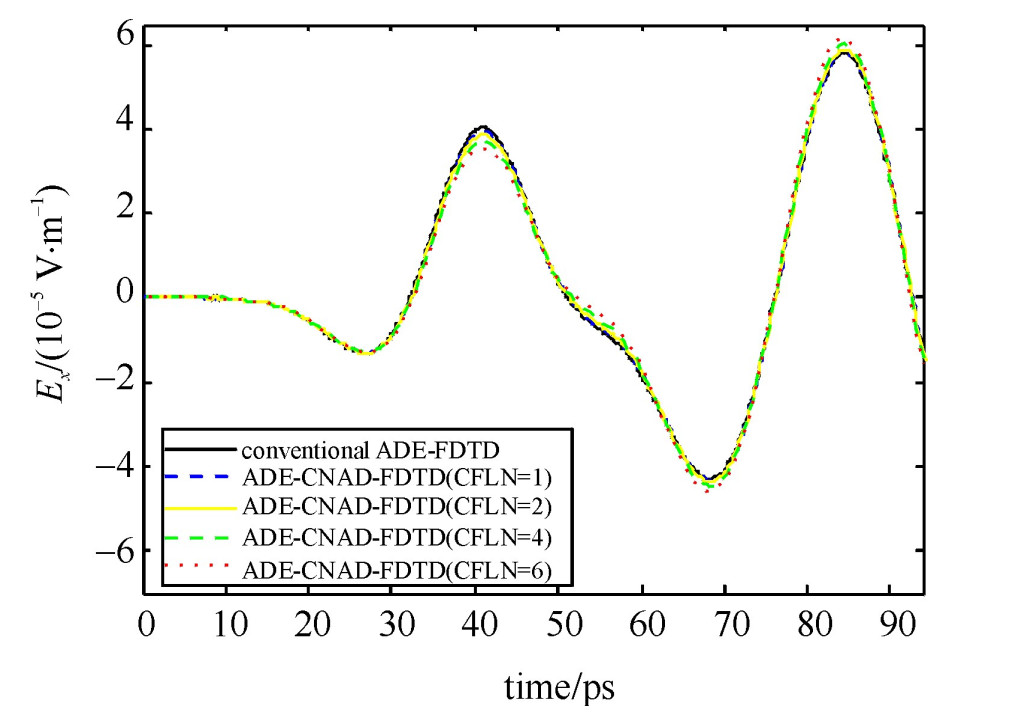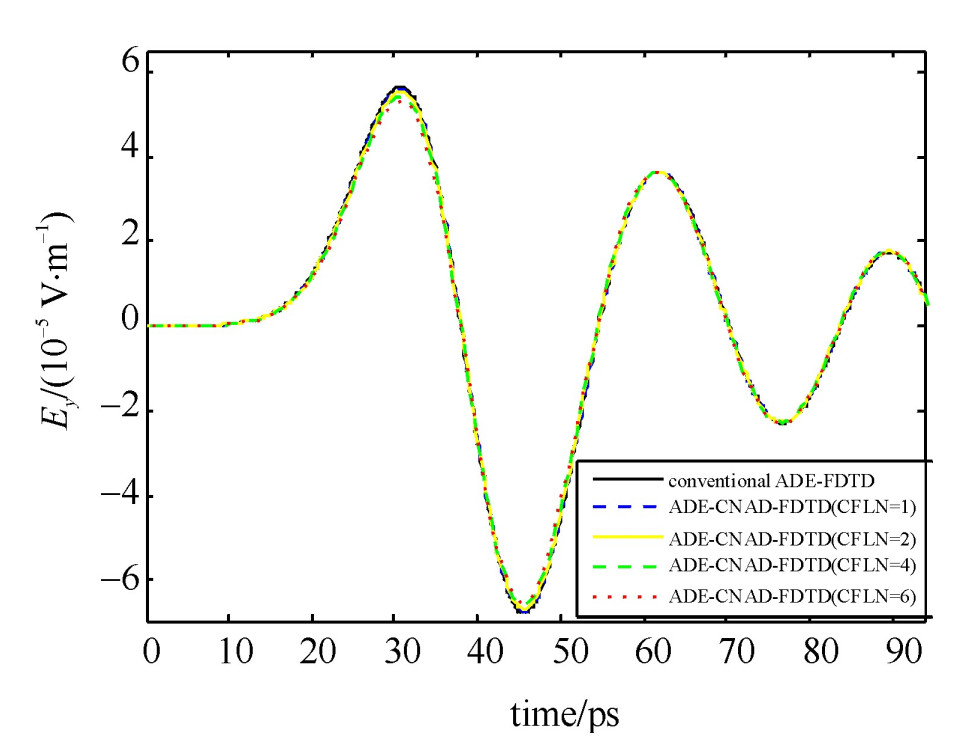Unconditionally stable auxiliary differential equation Crank-Nicolson-approximate-decoupling FDTD algorithm for 2-D anisotropic magnetized plasma
-
摘要: 针对二维各向异性磁等离子体提出一种有效的无条件稳定算法,新算法结合了辅助微分方程(ADE)方法与Crank-Nicolson approximate-decoupling(CNAD)时域有限差分算法仿真各向异性磁等离子体介质。传统的ADE-FDTD方法应用在一维各向异性色散介质具有较高的精度和效率,将提出的新算法ADE-CNAD-FDTD应用到二维各向异性磁等离子体介质中不仅解决了电磁波在具有各向异性和频率色散特性介质中传播的仿真难题,而且去除了CFL稳定性条件。该算法在保留了原有的精度情况下大幅度地提高了计算效率并成为无条件稳定的形式。给出一个算例证明该算法的有效性,通过模拟电磁波在磁等离子体中的传播,仿真结果与传统的ADE-FDTD算法对比,证实了该算法的高效率、无条件稳定性和高精度。
-
关键词:
- 辅助微分方程 /
- Crank-Nicolson approximate-decoupling算法 /
- 时域有限差分 /
- 磁等离子体
Abstract: An effective unconditionally stable implementation of the auxiliary differential equation Crank-Nicolson-approximate-decoupling finite-difference time-domain (ADE-CNAD-FDTD) algorithm for 2-D anisotropic magnetized plasma is proposed. The conventional ADE-FDTD method for 1-D anisotropic dispersive media has high efficiency and accuracy. This paper extends this method to 2-D anisotropic magnetized plasma with the CNAD scheme. The proposed formulations not only solves the problem that incorporates both anisotropy and frequency dispersion at the same time, but also eliminates the Courant-Friedrich-Levy (CFL) stability constraint. A numerical example has been carried out to validate the proposed formulations in the 2-D FDTD domain composed of anisotropic magnetized plasma. The results prove that the proposed formulations significantly save time and perform stably with acceptable accuracy. -
表 1 传统ADE-FDTD和ADE-CNAD-FDTD两种算法占用的时间和内存
Table 1. Time and memory used by conventional ADE-FDTD method and ADE-CNAD-FDTD method
ADE-FDTD ADE-CNAD-FDTD CFLN=1 CFLN=2 CFLN=4 CFLN=6 time/s 78.880 167.650 80.870 40.850 27.340 memory/MB 82.604 90.844 90.872 90.760 90.876 -
[1] Luebbers R J, Hunsberger F, Kunz K S. A frequency dependent time domain formulation for transient propagation in plasma[J]. IEEE Trans Antennas and Propagation, 1991, 39(1): 29-34. doi: 10.1109/8.64431 [2] 刘少斌, 莫锦军, 袁乃昌. 各向异性磁等离子体的辅助方程FDTD方法[J]. 物理学报, 2004, 53(7): 2233-2236. doi: 10.3321/j.issn:1000-3290.2004.07.040Liu Shaobin, Mo Jinjun, Yuan Naichang. An auxiliary differential equation FDTD method for anisotropic magnetized plasma. Acta Physica Sinica, 2004, 53(7): 2233-2236 doi: 10.3321/j.issn:1000-3290.2004.07.040 [3] Xu L J, Yuan N C. JEC-FDTD for 2-D conducting cylinder coated by anisotropic magnetized plasma[J]. IEEE Microwave and Wireless Components Letters, 2005, 15(12): 892-894. doi: 10.1109/LMWC.2005.859970 [4] Liu S, Zhong S, Liu S B. Piecewise linear recursive convolution FDTD method for magnetized plasmas[J]. Journal of Systems Engineering and Electronics, 2006, 17(2): 290-295. doi: 10.1016/S1004-4132(06)60050-9 [5] 杨宏伟, 袁洪, 陈如山, 等. 各向异性磁化等离子体的SO-FDTD方法[J]. 物理学报, 2007, 56(3): 1443-1446. doi: 10.3321/j.issn:1000-3290.2007.03.034Yang Hongwei, Yuan Hong, Chen Rushan, et al. SO-FDTD analysis of anisotropic magnetized plasma. Acta Physica Sinica, 2007, 56(3): 1443-1446 doi: 10.3321/j.issn:1000-3290.2007.03.034 [6] Taflove A, Hagness S C. Computational electrodynamics: The finite-difference time-domain method[M]. 3rd ed. Boston: Artech House, 2005. [7] Namiki T. A new FDTD algorithm based on alternating-direction implicit method[J]. IEEE Trans Microwave Theory and Techniques, 1999, 47(10): 2003-2007. doi: 10.1109/22.795075 [8] Sun G, Trueman C W. Unconditionally stable Crank-Nicolson scheme for solving two-dimensional Maxwell's equations[J]. Electronics Letters, 2003, 39(7): 595-597. doi: 10.1049/el:20030416 [9] Lee J, Fornberg B. A split step approach for the 3-D Maxwell's equations[J]. Journal of Computational and Applied Mathematics, 2003, 158(2): 485-505. doi: 10.1016/S0377-0427(03)00484-9 [10] Shibayama J, Muraki M. Efficient implicit FDTD algorithm based on locally one-dimensional scheme[J]. Electronics Letters, 2005, 41(19): 1046-1047. doi: 10.1049/el:20052381 [11] Sun G, Trueman C W. Approximate Crank-Nicolson schemes for the 2-D finite-difference time-domain method for TEz waves[J]. IEEE Trans Antennas and Propagation, 2004, 52(11): 2963-2972. doi: 10.1109/TAP.2004.835142 期刊类型引用(1)
1. 牛海华,王锋锋,王志军,刘鲁北,陈伟龙,李亚光,孙国珍,郑海,李智慧,张斌,何源. 基于3DE平台的协同设计在加速器装置建设中的应用——以CS30 α辐照装置为例. 强激光与粒子束. 2025(01): 63-73 .  本站查看
本站查看其他类型引用(0)
-






 下载:
下载:


